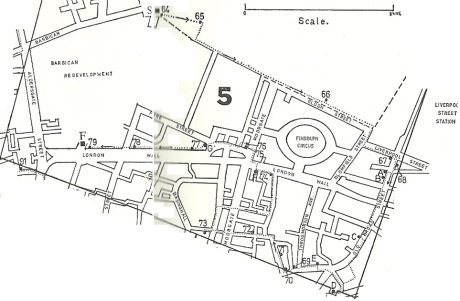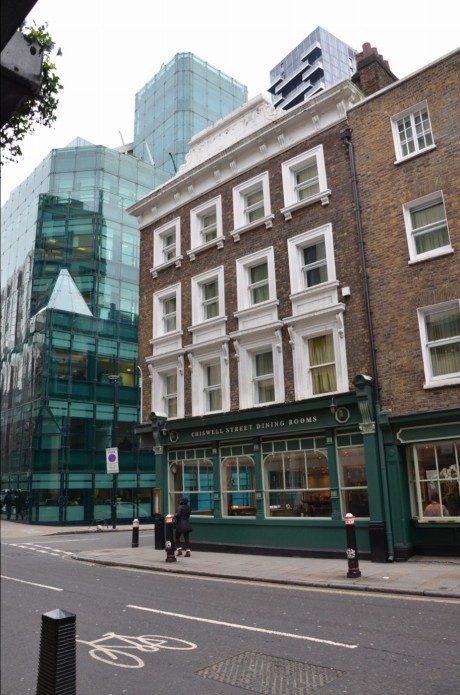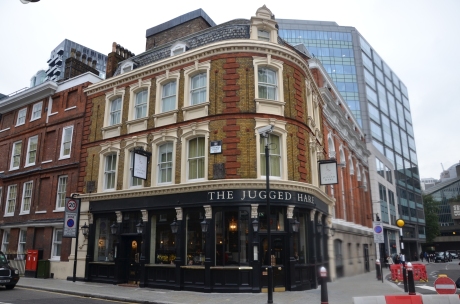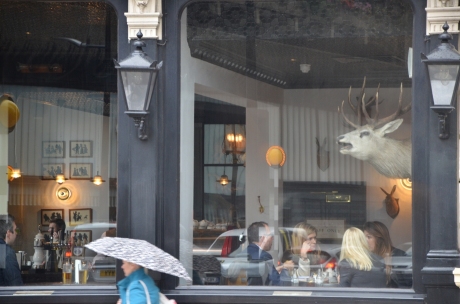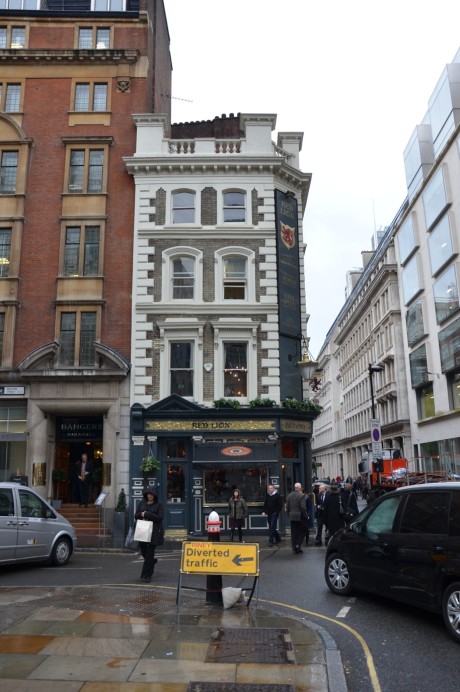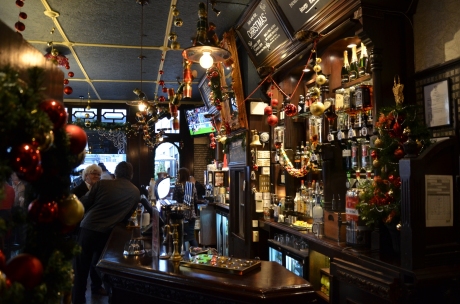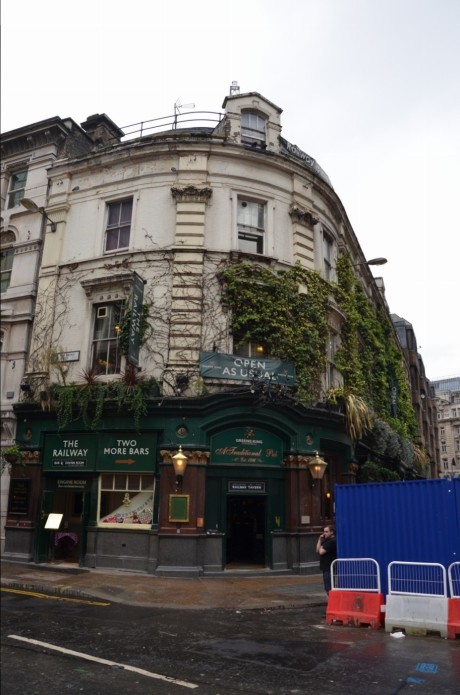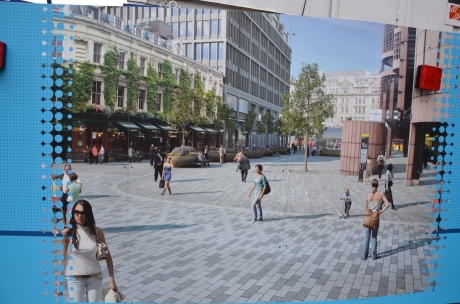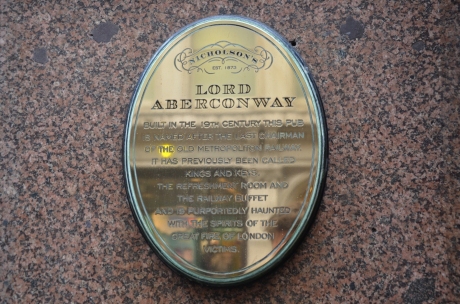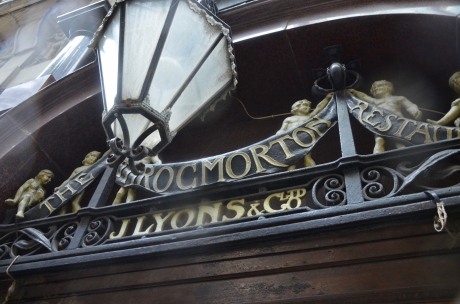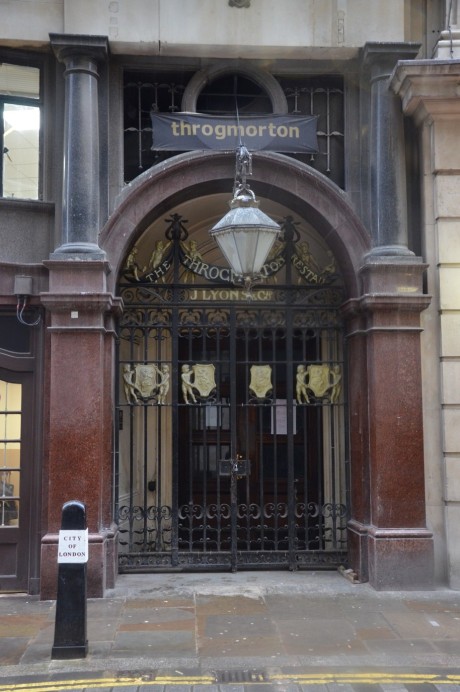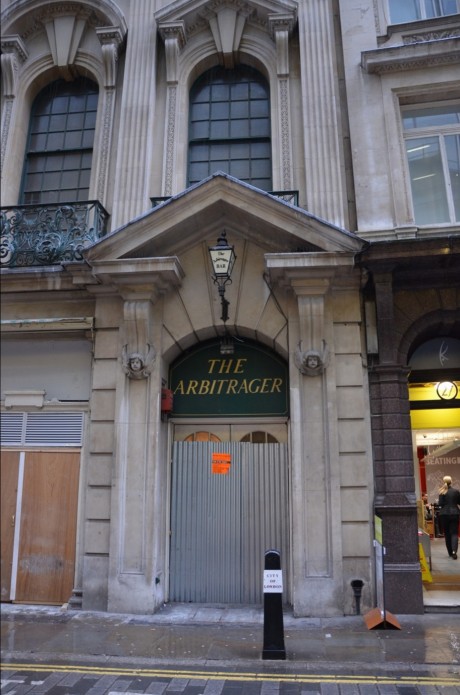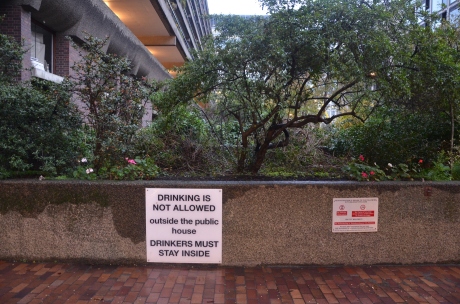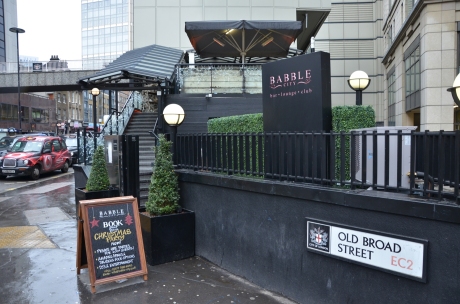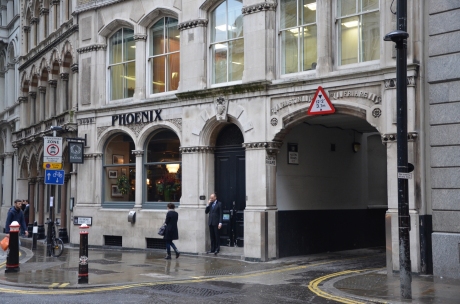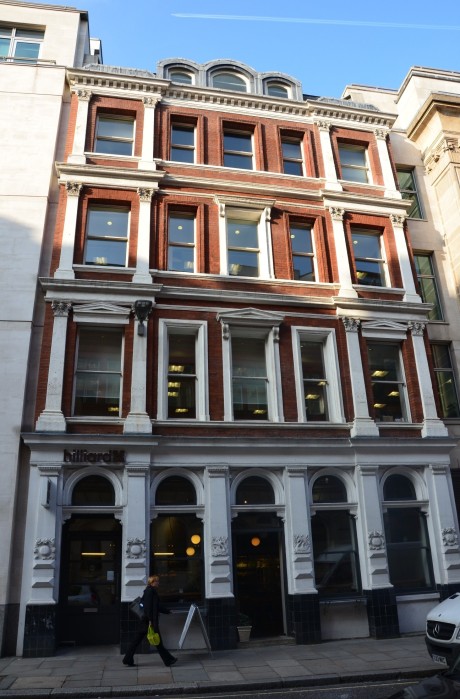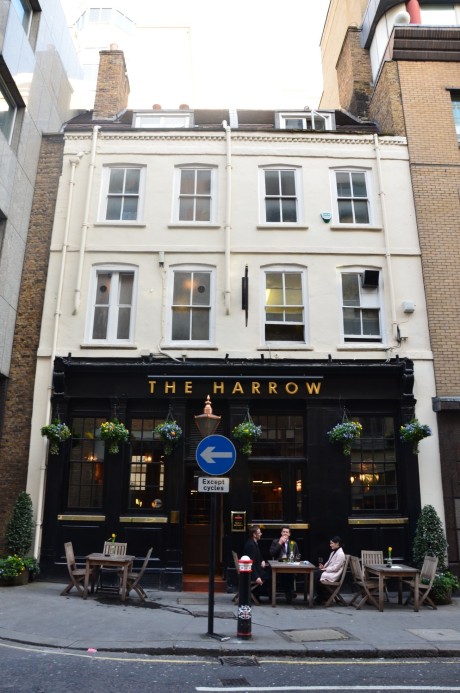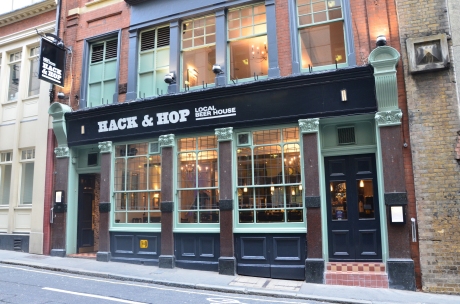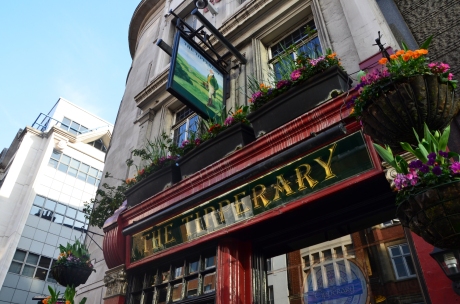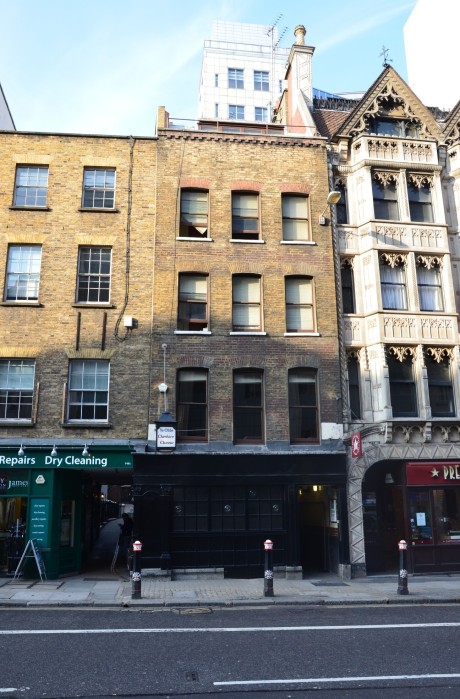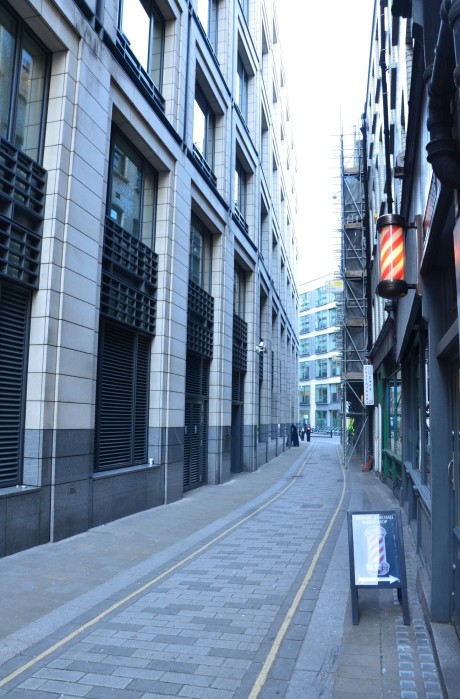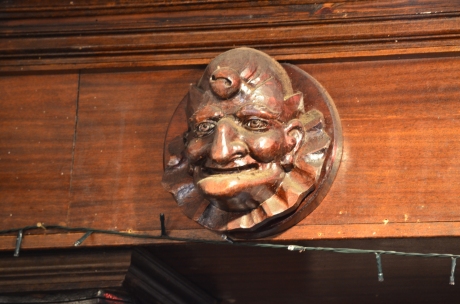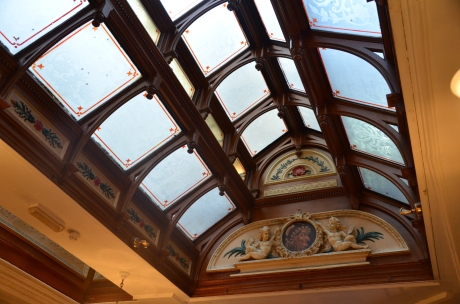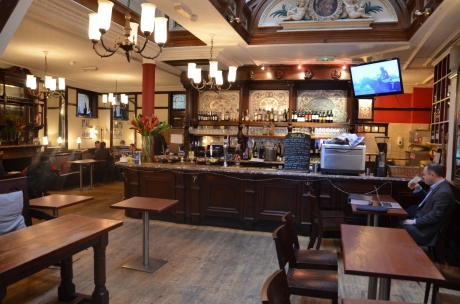City of London Pubs (1973): Forty Years On – Part 5
November 25, 2014
Please note: I’m jumping ahead here, but the long-delayed Part 1 will follow in the next week!
This is the fifth part of my walk following the route of City of London Pubs: A Practical and Historical Guide by Timothy M. Richards and James Stevens Curl.
AREA 5: THE BARBICAN, MOORGATE AND FINSBURY CIRCUS
For Richards and Curl, Area 5 was “our largest tour, topographically speaking” – but today, it’s the area which drives home just how much the City has changed in the last forty years.
 Once, this area was the heart of the City’s brewing industry. On Chiswell Street stood the Whitbread Brewery, founded by Samuel Whitbread in 1750 as the country’s first purpose-built mass-production brewery. On the wall outside, a stone plaque records a 1787 visit by George III and Queen Charlotte – their visit was commemorated with two rooms used for storing beer named in their honour.
Once, this area was the heart of the City’s brewing industry. On Chiswell Street stood the Whitbread Brewery, founded by Samuel Whitbread in 1750 as the country’s first purpose-built mass-production brewery. On the wall outside, a stone plaque records a 1787 visit by George III and Queen Charlotte – their visit was commemorated with two rooms used for storing beer named in their honour.
The brewery is no longer operating, but it was still a working brewery when Richards and Curl were writing in 1973 – they wrote that Whitbread’s “is now the sole survivor” of the City breweries, which had once been 40 strong – but it closed three years later in 1976.
The real damage to the City’s historic pubs started at this point, but it was really during the 1990s and early 2000s that the trade took a hammering it can never recover from. Bigger profits were to be found outside the pubs: in the value of the land and in other, more profitable, businesses.
The company used the Brewery as their headquarters until 2001, when they decided to wash their hands of the pub trade after two-and-a-half centuries. Their website proudly states:
In 2001 we became the company we are today. We sold our breweries [in 2000] and left the pub and bar business [selling off their pubs in 2001], refocusing on the growth areas of hotels and restaurants. Our reinvention as the UK’s leading hospitality business naturally coincided with the ending of this country’s brewing and pub-owning tradition, started by Samuel Whitbread over 250 years earlier.
Since 1995, Whitbread have owned the Costa Coffee chain, and this, along with Premier Inn and Brewers Fayre restaurants, has been the main focus of their business ever since.
The Whitbread Brewery was sold to an investment firm in 2005 and is now The Brewery, “a premier corporate venue” and “a leading conference space.”
I’ve been there for an awards-do and it’s very pleasant, but I can’t shake the feeling that are lots of other similar corporate venues dotted around the neighbourhood, and it would be far more special if it had remained a working brewery. Of course, that comes down to profit, and if that’s not there, what can you do?
The fate of the Whitbread Brewery was the same as many of the pubs which Richard and Curl visited in 1973, and their writing makes it clear they were largely unaware of the extent of the creeping destruction which was just around the corner.
This walk is close to a tipping point in my survey – this is the first walk where the number of lost pubs far exceed the number which have survived. Five pubs that Richards and Curl visited in 1973 are still here; but ten have gone. The City has lost so many pubs by this point in my survey that nearly half of the pubs which Richards and Curl visited in 1973 have disappeared.
The huge office blocks which now dominate the area have also entirely changed the area’s topography. What used to be a street with numbers neatly along its length has often been replaced with vast glass atriums with company names etched onto the glass, and entire sections of the roads have been replaced by single buildings. Occasionally, this has made it hard to pinpoint the exact locations of lost pubs.
Additionally, there seems to be a concerted effort to hide road names when office blocks have taken over. Many street signs (some of them very old signs themselves) are placed high above the level of the street, often on one side only and at angles that make it almost impossible to see. Why this should be, I have no idea.
No.64 – THE KING’S HEAD, 49 Chiswell Street, EC1
Noting that Chiswell “is probably a corruption of the brewery’s ‘choice well’”, Richards and Curl call The King’s Head the “first of the Whitbread brewery taps…The interconnected saloon and public bars are always bustling, patronised mainly by brewery workers and men from the Barbican site. The small saloon lounge inevitably fills up in no time at all…A large mural depicting the brewery in olden days graces one wall.”
The pub has now gone, replaced with a smart bistro called The Chiswell Street Dining Rooms, which stretches four shop-fronts along the road. There is a bar inside, but it is certainly not a pub – the menu outside sounds delicious, but anywhere offering “prune and Earl Grey tea puree” on the side of a dish is definitely a restaurant.
As is often the case when I wander around the City with a camera, a gentleman who worked at the Dining Rooms came over to ask me what I was doing when I was photographing the building. As soon as I’d said “I do a blog”, he immediately relaxed and told me to pop in for a drink if I fancied. I can tell you that isn’t the usual response I get – some people have asked me for “ID proving you’re a historian”, which I don’t think actually exists – so thanks to him. I didn’t have the drink, but I appreciated the gesture.
No. 65 – THE ST PAUL’S TAVERN, 56 Chiswell Street, EC1
At the junction with Silk Street, on the other side of the Brewery’s entrance from the King’s Head, formerly stood the St Paul’s Tavern, a “popular pub” where “space…is always at a premium.” It has now been renamed the Jugged Hare, and while more obviously a pub than the Chiswell Street Dining Rooms, it is not what anyone could term a boozer.
Looking at the menu outside, I noticed the bottom of the menu has the same details as the one outside the Chiswell Street Dining Rooms, noting it was owned by ‘the ETM Group’. Slightly lower priced than its sister business, it was similarly filled with suited City types and certainly isn’t the sort of place you’d wander into wearing jeans and carrying a copy of the Racing Post.
The problem here is that if it looks what a pub traditionally looks like, it has a bar and it serves a decent pint of beer, is it still a pub? I’ve thought about this a lot for the purposes of this survey, and I’ve come to the conclusion that it isn’t necessarily.
There are certain things which are integral to pubs that go beyond that – could you pop in for a swift half with two mates on the way to a gig? Could you nip inside to keep out of the rain, and nurse a half for the best part of an hour? Would you go there on a Sunday morning to read the papers? Is the bar the focus of the building as opposed to the restaurant? The answer to all those questions is no.
It might seem as if I’m splitting hairs, but I think the main purpose of a pub has to be to primarily serve alcohol to people in a social environment. If the main focus is on food, and not on serving beer, then it’s a restaurant. So while the Jugged Hare looked very nice, it’s not any longer what I think can be termed a pub.
No. 66 – THE RED LION, 1 Eldon Street, EC2
As Richards and Curl state, the Red Lion (like the two previous businesses) is ever so slightly outside the boundary of the City, but aside from saying its busy, they spend little time on the overall look. Perhaps it’s due to the glass cliffs which now tower above it, but the Red Lion looked terrifically inviting from the outside, and more so when I looked through the door.
Run by Taylor Walker, it’s a snug, dark wooden room which was full of pre-Christmas afternoon cheer.
No. 67 – THE RAILWAY TAVERN, 15 Liverpool Street, EC2
“Standing as it does opposite Broad Street and Liverpool Street Stations, The Railway is an obvious place to down a quick pint while waiting for a train. More trains have been missed for this reason than all others put together we suspect. The second of Whitbread’s ‘theme’ houses (owned jointly with Bass), this one is a real Mecca for railway enthusiasts. The large, once stately, lounge houses numerous prints, photographs, and notices concerning railway history. Two models stand out in particular – an LNER Coronation Coach and the London, Brighton & South Coast Railway’s ‘Jenny Lind.’”
While these pieces of railway memorabilia have long gone, The Railway remains, now subdivided into bars: the main one, an upstairs bar and dining room called The Engine Room, and one smaller round the back, named the Citybar – a name that immediately makes me think of 1980s Yuppiedom (perhaps also because it comes complete with a stained glass window reading ‘Wine Bar’ above.)
Not withstanding the handsome sub-classical exterior, the inside is a bit gloomy, with the darkness punctured by the flash of fruit machines, Sky Sports on the flatscreens and an Atom-bomb-bright board on showing rotating adverts for Now That’s What I Call Music compilations and local estate agents. It hadn’t put many people off, as it was busy inside.
Next door, the pub’s proximity to the railway was spelled out: Crossrail’s redevelopments are taking place, but it’s a relief to see the pub incorporated into the developer’s idealised vision of the future of the area.
No. 68 – PATMAC’S RAILWAY BUFFET, 73 Old Broad Street, EC2
“Essentially, as its name suggests,” wrote Richards and Curl in 1973, “Patmac’s (Patrick & Macgregor) is a buffet bar for Liverpool Street Underground Station…It is interesting to note that Liverpool Street should have a buffet bar here, as it is now the only tube station apart from Sloane Square possessing a bar actually on the platform.” While the Liverpool Street tube bar is long gone, Patmac’s is still operating, although now it goes by the much preferable name The Lord Aberconway.
A lovely Victorian bar – probably the most handsome interior of all the pubs on this walk – it’s run by Nicholson’s, who are one of the few brewers to proudly retell the history of their pubs on handsome plaques outside (I award extra bonus points for mentioning ghosts and/or the plague). The name change – Lord Aberconway was the last chairman of the Old Metropolitan Railway, which amalgamated with other lines in 1933 to form the Underground as we know it today – is relatively recent, but the pub itself (despite the frequent name-changes) looks as if it has been largely unchanged for years.
Letter E – THROGMORTON BAR, 27 Throgmorton Street, EC2
No.69 – THE BODEGA BAR, 30 Throgmorton Street, EC2
Throgmorton Street was, for many years, dominated by the bars along it, serving the workers in the nearby Stock Exchange.
During the 1970s, the Throgmorton Bar was “a darkly-panelled bar in vaguely seventeenth-century style, with ‘period’ plaster ceiling in the Jacobean manner…the showpiece of this bar is, however, undoubtedly the mosaic-clad stairwell that leas down to the basement. The stairs winds it way round an elegant wrought-iron cage containing the lift shaft. The mosaics are richly colourd, with classical Pompeian friezes and much use of gold.” Its near-neighbour, the Bodega Bar, was “a remarkably long, narrow bar…based on a styling vaguely art nouveau. The walls are subdivided by pilasters of alabaster and marble, and the plaster ceiling is enriched with sub-Art Nouveau and Rococo motifs.”
While not doubting Richards and Curl’s appreciation of these places (it sounds a little like the decor of these bars might not be to modern tastes), all have since disappeared over the years as whatever redevelopment is happening in Throgmorton Street continues to not happen.
Unlike most City developments, there are no signs promoting any new developments ‘coming soon’, even though it looks as if the road is definitely being prepared for redevelopment.
Throgmorton’s closed in 2008, the long-running Throgmorton’s restaurant (responsible for the elaborate metalwork along the road, most of it dating from the time the restaurant was owned by the Lyon’s chain) in 2013, and a pub not mentioned in City of London Pubs called The Arbitager was the last to be operating in the main portion of the road.
I went in once a few years back, and it was simply unique – with the racing on, and unpainted walls, it looked more like a Dickensian hole-in-the-wall gin shop than a pub. No less exciting for that. Now it too has gone the way of all the rest.
No.70 – MOORE’S BAR, 34a Throgmorton Street, EC2
At the lower end of Throgmorton Street, where Moore’s Bar once stood – “below pavement level, the subterranean bars are loaded with Victoriana, especially mirror advertisements of the late nineteenth century, stuffed fish and other period bric-a-brac” – the buildings have all been demolished and are awaiting office blocks.
No.71 – BIRCH’S, Angel Court, Ec2
“Chiefly a wine house,” note Richards and Curl, “the shop front, with its three semi-circular leaded windows, is a passable replica of part of the eighteenth-century original [Birch’s wine shop in Cornhill]…the interior is small and intimate, with a board floor. There is a splendid open screen of vaguely Gothick style separating the front bar from the rear alcove containing tables – a most charming feature.” All these features have now gone, along with the historic name – the only business along the street in a building similar to the one Richards and Curl described is the Mint Leaf Lounge, a huge open plan bar which looks a lot of the lobby of an expensive hotel, all honey lighting and strange human-shaped silver statues.
No. 72 – THE BUTLER’S HEAD, 11 Telegraph Street, EC2
New in 1973 – “another undistinguished addition to the City” – this pub has since been replaced by a later office block with a pub underneath called The Telegraph.
By far the largest of all the pubs I saw on this walk – honestly, you could take the tables and chairs out and play a football match inside – The Telegraph is run by Fullers. It’s newness makes it look like a branch of the Slug and Lettuce and it lacks charm – but I suppose its main purpose is to cater efficiently for large numbers of workers on a weeknight rather than act as a cosy local.
Due to the fact that neither Richards nor Curl would recognise this site in the slightest, and the fact the name of the pub which used to be on this site has been lost, I’m counting this as a new pub which has opened on the site of an old one which closed.
No.73 – YE OLDE DOCTOR BUTLER’S HEAD, Masons Avenue, EC3
Set in a beautiful avenue of half-timbered, narrow old houses, this pub was named after Dr William Butler, the Court Physician to King James I. Famous for inventing a popular medicinal ale, the pub which takes his name is old, but was significantly remodelled in the 1920s.
Largely preserved since then, when I visited it had been renamed The Movember Arms to promote the excellent men’s health charity Movember. Hopefully this renaming is just for the month of November – I must admit, it’s so professionally done, there’s a part of me that’s ever so slightly worried it won’t be changing back. Thankfully the barrels hint the name isn’t here to stay…
No. 74 – THE STIRLING CASTLE, 50 London Wall, EC2
“A late nineteenth-century pub with a strongly designed exterior,” wrote Richards and Curl, “somewhat spoiled by the loss of its original glass.” More than the glass has gone now – the entire pub and surrounding buildings have been demolished and replaced with the ubiquitous office block with shop units underneath.
The lack of numbering on this faceless block means its hard to tell exactly where the pub would have been – it looks to be where LA Fitness is. A couple of original metal plaques have been salvaged by the developers and pinned to the front of the modern building like the scalps of defeated enemies – one, which reads ‘SCS 1886’ seems to fit the date of the old pub given by Richards and Curl, with the ‘SCS’ perhaps incorporating the initials of ‘Stirling Castle.’ This is just a guess – if anyone knows any better, please let me know!
No. 75 – THE GLOBE, 83 Moorgate, EC2
“The Globe is one of those pubs that no one knows by its real name; it is universally known as The 199.” While I don’t think anyone knows the pub as The 199 these days, the Globe is still standing, huddled together at the edge of a small group of old buildings kept standing as all the surrounding ones have been knocked down to build offices.
Huddled together amidst the skyscrapers, the Globe is a hardy survivor –“it was mentioned in 1734 in records of the Clockmaker’s Company, and we know that John Wilkes ‘dined at Globe near Moorgate’ in 1770.” Nowadays there don’t seem to be many radicals coming through the doors, only City workers having a couple of pints before heading to Moorgate station just a few wobbly steps away.
No. 76 – THE MOORGATE, 85 Moorgate, EC2
Located directly next door to the Globe in 1973, the inn was once known as The Swan & Hoop, and it was here that the poet John Keats was born in 1795 (his father managed the livery stables at the inn, although whether Keats was truly born here or at his parent’s unidentified nearby house is lost in the mists of time.)
The Moorgate is no longer running, having been swallowed by its neighbour at some point and renamed ‘Keats at the Globe’, although I’m not entirely certain if they are actually connected as a whole. The house bears a plaque commemorating Keats’ birth and the house – not original to the time Keats was born and now looking really tired –probably has its famous connection to thank for escaping the redevelopment which has started one door down. As the pub is now just an overspill of The Globe, I am counting it as lost.
No.77 – THE PLOUGH, St Alphage Highwalk, London Wall, EC2
No. 78 – THE PODIUM, St Alphage Highwalk, London Wall, EC2
No. 79 – THE BARBICAN, St Alphage Highwalk, London Wall, EC2
These pubs were “three new highwalk public houses” located in the Barbican development (which, at the time of Richards and Curl’s 1973 book wouldn’t be completely finished for another three years.) All were situated on the same Highwalk (the name given to the passageways in the complex which were high above street level), all appeared during the early 1970s, and all shut during the 2000s, ahead of a redevelopment of the fringe on which they were situated.
Along with the pubs, St Alphage Highwalk has itself been terminated.
It currently leads nowhere, blocked off at one end and cut off at the other, as ‘London Wall Place’ (another office) is erected on the site where the pubs once stood, alongside a universally unloved late-1950s skyscraper named St Alphage House. The small parade of shops on the site always underperformed and the units had been empty for a number of years. After the recession stalled a number of projects, the parade and St Alphage House were finally demolished earlier this year.
There are still two places to get a drink by the Barbican, however: situated on Moorfields Highwalk is the City Boot…
…while close by the Church is Wood Street, a restaurant which also serves drinks. It has a pub sign outside and a snooker table (although with red baize, which I have problems with), so I’m happy to count it as a pub. It was formerly known as the Crowders Well before its current incarnation.
It also has a sign outside that pleased me greatly. “Drinking is not allowed outside the pub. Drinkers must stay inside.”
That’s what people who use pubs should always be. Not customers, not guests, not patrons.
Drinkers.
Two quick notes
In this walk, Richards and Curl also included a number of wine bars (or as they had it, places that were “not a pub in the true sense of the word, but included as a drinking establishment”), which they chose to letter from A to F, rather than number like pubs. All but one of them – Gow’s Oyster Bar on Old Broad Street, which looked like a great place to go at Christmas and was fit to bursting with bald businessmen enjoying a late seafood lunch – have long gone, as, unlike pubs, when the owner left, the business didn’t continue. As such, I have left them off this survey, as I have done with new wine bar/club places, such as Babble City (which looks as if it was specifically designed to scare off anyone over 30) on Wormwood Street.
Additionally, a few proper new pubs have appeared in the forty years since City of London Pubs was written. At no. 26 Throgmorton Street is the Phoenix, a large cavern of a place with dark wood interior…
…and on Wormwood Street sits the King’s Arms, a Taylor Walker pub situated underneath a tower block which must have sprung up in the years following Richards and Curl’s book.
THE TALLY SO FAR:
Pubs covered in 1973′s City of London Pubs still open: 32 (4 renamed)
Pubs covered in 1973′s City of London Pubs now closed: 31
Pubs covered in 1973′s City of London Pubs which had closed and are now open: 1
Pubs opened since 1973’s City of London Pubs: 6
City of London Pubs (1973): Forty Years On
March 13, 2014
City of London Pubs: A Practical and Historical Guide was published in 1973. A charming gazetteer written by Timothy M. Richards (“a public-house manager with a keen interest in the history of pubs”) and James Stevens Curl (“an architect with ‘a great interest in pubs, taverns, inns and drink’”), the content is both historically thorough and winningly casual as the two men catalogue the pubs of the City, which, as the cover states, “has, in fact, a higher density of pubs than any other comparable area in England, Scotland or Wales.”
Throughout the book, the two gently hammer home that the only way to truly enjoy the City pubs – while they may be beautiful, architecturally impressive or historically important – is to drink in them. This mission statement is launched with a quote from GK Chesteron’s A Ballade of an Anti-Puritan:
Is it not true to say I frowned,
Or ran about the room and roared;
I might have simply sat and snored –
I rose politely in the club,
And said “I feel a little bored;
Will someone take me to a pub?”
“Follow us!” Richards and Curl reply.
The book “takes the form of several pub crawls which even the most dedicated imbiber would need days to complete.” Richards and Curl split the City pubs into ten areas, “each area including a manageable number of pubs.” A manageable pub-crawl was clearly a more serious undertaking in 1971: the shortest crawl the book suggests is fourteen stops, the longest 23.
Perhaps this explains why their acknowledgements at the end of the book thank the person who typed their manuscript “from a less than tidy original”, and the police “for their good humour.”
When I first picked up the book and got stuck into it, it was a surprise to realise it was written 43 years ago. It certainly doesn’t read that way. In fact, I can’t think of a better book about the City’s pubs – or any guide to pubs, for that matter – than this one.
“Many books have been published concerning the City churches and the famous public buildings and even one dealing with the loos,” the authors write in the foreword. “But there is no comprehensive guide…After all, there are about 200 drinking establishments in the City, including wine bars, and these are well worth a study in themselves. Many older books, while devoting whole chapters to the City, are unfortunately out of date, or too clumsy.”
But while it isn’t ever clumsy, City of London Pubs has sadly joined those out-of-date books. The authors were only too aware of this inevitable fate – in the introduction, they clearly state “the information in this book is correct at the end of December 1971. As far as possible subsequent changes have been incorporated, but these cannot be guaranteed.” Their appendix demonstrated just how quickly things changed: it lists four pubs featured in the main body of the book, which had been demolished by the time of publication.
Thankfully, some of the gloomy apprehensions they raised about the future of pubs in the City have not been realised.
The seemingly unstoppable rise of the City wine bar was a twenty-year fad, and today many of these invaders have been supplanted in turn by branches of Itsu, Pret A Manger and vast corporate headquarters.
Richards and Curl lamented that “the traditional inn signs are fast giving way to neon atrocities”, but this too turned out to be a passing craze.
They also complained of a new ill: inexperienced barmaids, used only to pouring lager through a tap, who refused to pour natural beers into glasses and instead expected customers to come round the bar to do it themselves. They feared the solution to this problem would be pubs “refusing to stock the last few real beers containing sediment in the bottle. Despite a touch-and-go period in the 1980s when lager looked like it would batter bitter into submission, the demise of real ale never came to pass –today, you can probably get more varieties of natural beer in London that at any other point in its history.
In March 2014, I set out to walk in the footsteps of City of London Pubs, to see what changes have happened in the forty-three years since it was published. In an exact reverse of Richards and Curl’s work, I’ve kept my written notes to a minimum but have included photos of each pub (or if its been demolished, whatever’s replaced it.)
The main change I noticed, apart from the demolition of a number of pubs, is the total abscence of separate bars – the public bar, the saloon bar – some of which the book mentions were still in situ in the 1970s but all of which have since been removed.
Should you happen to have a copy to hand, this entry covers Richards and Curl’s first and fourth areas, which covers the ground from Fleet Street to Southwark Bridge (despite the numbering, Areas 1 and 4 border each other.) The numbering of the pubs is the same as it appears in the book.
AREA 1
No. 1 – YE OLDE COCK TAVERN, 22 Fleet Street, EC4
Like many pubs in the City, Ye Old Cock Tavern boasts a connection with Pepys (who visited in April 1668 with the actress Mrs Knipp, where he “drank, ate a lobster, and sang, and mighty merry”), but the present building is a relatively recent home dating from the mid-1880s. Previously, The Cock was situated in Apollo Court, on the opposite side of Fleet Street – the opening of a new branch of the Bank of England forced the move.
The dark, rather cavernous pub remains much as described in the book.
No. 2 – THE CLACHAN, Old Mitre Court, Fleet Street, EC2
A modern pub “with a small upstairs bar and a large dive bar and restaurant” built close to the site of the ancient Mitre Inn (Dr Johnson’s ‘place of frequent resort’), this has disappeared since the book was written – indeed, the lack of a specific address in the tiny square makes it hard to tell where it originally was. The only thing which remains is the Bishop’s Mitre above the door of a spectacularly boring looking office opposite.
No.3 – EL VINO’S, 47 Fleet Street, EC4.
One of the most famous of London’s drinking establishments, “the suitably sombre and discreet” El Vino’s is still going strong.
No. 4 – THE WELSH HARP, 3 Temple Lane, EC4
Back in 1971, the Welsh Harp was “a large pub of four storeys, the ground floor having an arcaded treatment of late Victorian date. Above, the stock-brick facade has rubbed red-brick arches over the windows, and there is a plain crowing cornice.” In 2014, there is absolutely no trace left of the pub but the “arcaded” ground floor can still be seen.
Bar the ancient looking stone bumper on its corner (which is clearly still protecting the building from the side-swiping construction lorries constantly winding through these narrow roads), the building in its place felt so uninspiring, I forgot to even see what it was.
No. 5 – THE WHITE SWAN, 28-30 Tudor Street, EC4
In 1971, the White Swan, with its interior “in mid-1930s style”, was “a good homely local, known to everyone as The Mucky Duck.”
In 2014, it has gone – in its place is a sandwich / salad bar with the not particularly sandwichy-salady-bar-name of ‘Hilliard’. On each side of the door remain two stone white swans, the only reminder of the building’s former life.
Since the 1970s, even the road layout has changed. Where the White Swan was once the corner building on Tudor Street, Tudor Street no longer exists – its former route is now covered by the vast monolithic offices of an international global law firm.
No. 6 – THE HARROW, 22 Whitefriars Street, EC4
While the divided bars that were present in 1971 have been removed and numerous internal refits have been performed over the years, the Harrow is still serving. Unusually, it has entrances on both sides of the pub – front and back.
No. 7 – THE COACH AND HORSES, 35 Whitefriars Street, EC4
A pub with an original late Victorian facade, it had been modernised by 1971 so that “the charming front is all that remains.” Today, the pub – or as the front has it, “local beer house” – has changed its name from The Coach and Horses to The Hack and Hop, presumably a late nod to the area’s journalistic history. Having walked the whole of the area, this is the only contemporary-looking pub-restaurant I came across.
No. 8 – THE TIPPERARY, 66 Fleet Street, EC4
Proclaiming itself “London’s oldest Irish pub”, the pub was opened on the site shortly after 1883 (although the name The Tipperary is more modern.) In 1971, it was “a long, narrow pub in traditional Irish urban style, with rich, dark panelled walls; engraved green glass panels with gilt lettering advertising whiskey and stout; carved display stands; mirrors; and resplendent lamps.” It’s largely the same four decades later.
No. 9 – THE FALSTAFF BAR, 67 Fleet Street, EC4
A “small, narrow bar in the basement of a restaurant” which was all that remained of a “once much larger house called The Falstaff, which closed in 1971”, there was absolutely nothing to signify any bar had ever existed on the site in 2014.
No. 10 – YE OLDE CHESHIRE CHEESE, Wine Office Court, 145 Fleet Street, EC4
One of the capital’s best known inns, it is probably the last pub in the City which will ever be changed. While the tourists enjoy the smoky fires and the faux-grubbiness inside, it’s worth taking a moment to admire the less remarked-upon exterior “with its sash windows, wooden panels, fanlight, and great hanging sign…an excellent example of the sort of pub front that existed in the eighteenth and nineteenth centuries.”
No. 11 – THE KING AND KEYS, 142 Fleet Street, EC4
Almost next door to the Cheshire Cheese, in 1971 the King and Keys could boast a ceiling which “lowered by means of large wooden square” and which “incorporates lights and two applicable motifs. One is a rose, crossed keys, and a knight’s head; the other an orb, crossed maces and a crown.” The pub closed in 2009, and the building is now a Mexican takeaway snack bar.
No. 12 – THE COGERS, 9 Salisbury Court, EC4
In 1937, the eighteenth-century inn (whose name came from the Ancient Society of Cogers, a debating group who made the pub their home) was reincorporated into a modern building built for Reuters by Sir Edwin Lutyens. In 1971, Richards and Curl reported that the Cogers was large and “very much of its period…subdivided spaces give it a pleasant atmosphere…the screens have opaque glass set in; leaded lights are provided, even in the doors; and the bar is panelled, with rails.”
Today, the pub has disappeared – in 2009, the redevelopment of the building saw it replaced with a Sir Terence Conran-designed restaurant called Lutyens. The restaurant is actually on the other side of the road from where I took this picture – when I saw the restaurant, part of the grand deco building, it didn’t strike me that a pub could ever have been there. It was only later I was able to place where it was – so until I go back, here’s the view that the Cogers used to look out on.
No. 13 – THE OLD BELL, 95 Fleet Street, EC4
Originally built in 1670 for Sir Christopher Wren’s workmen, who were rebuilding St Bride’s after the Great Fire of London in 1666, the pub has changed its name numerous times over the centuries. The glass window which Richards and Curl admired in 1971 is still present in 2014, and the pub itself is little changed.
No. 14 – THE RED LION, Poppins Court, EC4
In 1971, Richards and Curl admired the Red Lion, “a decent three-storey building…good panelled ceiling and mirrors contribute to the late Victorian atmosphere…the dark wood of exterior and interior, yellowed walls and old ceiling all bear witness to a distinct lack of youth.” They also noted that “above the alleyway’s entrance one can still see the original tavern sign with a popinjay (a corruption of which gave the court the name Poppins) or parrot carved in stone.”
In 2014, all this has been comprehensively wiped away. The gap between the buildings is still called Poppins Court, but it couldn’t look any less like a Court, or any more like a service road cowering in the shadows of the towering office block it serves.
No. 15 – THE PUNCH TAVERN, 99 Fleet Street, EC4
Largely unchanged since 1971, the Punch Tavern has some lovely brassy Victorian plasterwork and decor – the closest one comes to seeing a gin palace on this walk.
Carvings of Punch and Judy above the bar, paintings of Toby the Dog in the tiled mosaic entranceway, a great glass skylight, dark wood and mirrors everywhere…
…but as Richards and Curl pointed out 40 years ago, “originally the space would have been subdivided and much more intimate in character. It is far too open and almost intimidating now.” It may be too open, but it’s not intimidating – when I went in, the staff couldn’t have been nicer and the clientele consisted of a few businessmen and two women with babies eating lunch. That said, it’s hard to deny that the entrance is much more fun than the inside.
No. 16 – THE ALBION, 2-3 Bridge Street, EC4
Still open, the Albion is still “a popular lunchtime rendezvous for eating, set within an undistinguished late-Victorian building.” When I walked past, even though it was gone 3pm, it was still full of City workers stuffing sausage and mash into their mouths.
No. 17 – THE ST BRIDE’S TAVERN, Bridewell Place, EC4
Up past a huge Premier Inn – the largest one I’ve ever seen, it looked like a terrifying battleship – is St Bride’s Tavern. In 1971, the authors of City of London Pubs said it was the type of comfortable pub which could become anyone’s local – but it’s a rather severe building which today hides a fairly unremarkable interior. It was the only pub I passed in the entire walk which was empty when I looked in. Good for the rest.
THE TALLY SO FAR:
Pubs covered in 1973’s City of London Pubs still open: 10 (1 renamed)
Pubs covered in 1973’s City of London Pubs now closed: 7
NEXT UP: AREA 4!
